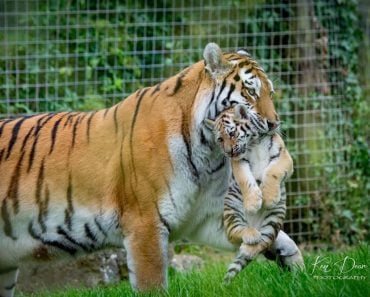Table of Contents (click to expand)
Cats and dogs will present each 0ther with their kills, or will present their human companions with kills. This is because, to dogs, human companions are a member of their pack or family, and to cats, humans—and other feline or canine companions—are akin to their offspring or members of their clan.
It’s deep-clean Sunday. You’ve reorganized all your cabinets and vacuumed your entire house. It’s taken hours, but everything is exactly where it should be and your house is cleaner than a hospital.
You sit down, ready to finally relax, as you wonder to yourself, “Hmm…I haven’t seen my cat in a while. I wonder where he is?”
Naturally, you set out to look for your cat.
To your absolute horror, you follow a trail of blood and entrails to your bedroom. There, proud as can be, you find your cat playing with what’s left of a dead mouse. With a lack of remorse, your cat walks over to you with the strut of royalty and presents you with her kill, as if she’s doing you a favor.
If this sounds familiar, don’t worry, your cat isn’t psychotic. Nor is she actively trying to undermine your cleaning efforts. In fact, this is quite a common feline (and canine!) behavior. Let’s explore why our cats and dogs present us with their kills.
Recommended Video for you:
It’s All About Instinct
Although cats and dogs have been domesticated for over 10,000 years, they still retain quite a few of their wild instincts. Wild felids and canids, particularly females, are very accustomed to hunting for themselves. Domestic cats and dogs are no different.
We might look at our pet cats and dogs and see fluffy little cuddle buddies, but make no mistake… they’re still very, very good at hunting. More than anything, they are driven by their instinct to survive. Essentially, this means that they’re still top predators.
In the wild, as female canids and felids are generally responsible for hunts, mother cats and dogs teach their younger sisters and offspring how to survive. This training includes learning how to track down prey, how to strike at them, and surprisingly enough, how to eat them. We generally don’t think about it, but even human babies must be taught how to eat.

In both multi-pet and single-pet households, cats and dogs will present each other with their kills, or will present their human companions with kills. This is because, to dogs, human companions are a member of their pack or family and to cats, humans—and other feline or canine companions—are akin to their offspring or members of their clan.
Most modern-day pets are spayed or neutered to better ensure their own safety. However, this deprives them of passing on their hunting wisdom to another generation. Thus, to live out their natural role as mothers or teachers, cats and dogs will present catches to their surrogate human families instead.
A backhanded compliment

Conclusion
Next time your pet presents you with a dead (or in some gruesome cases, alive) mouse, remember to think of all the blood and guts as a fitting symbol of the love your pet harbors for you.
It also speaks volumes in terms of how comfortable your pet feels in your house. Even in the wild, after a successful hunt, predators will often hide their spoils in safe locations, such as dens or bushes. Modern-day cats and dogs treat their homes the same way. After a successful hunt in the yard, pets will often drag their spoils into places where they feel most comfortable.
It isn’t fully feasible to eliminate this behavior entirely, but veterinarians always recommend keeping pets indoors unless you can keep an eye on them.
In fact, both veterinarians and conservationists alike recommend minimizing this behavior as much as possible. This is because domestic and feral cat and dog populations pose huge threats to local wildlife species.
In Australia, the government has even integrated 24-hour cat containment in their larger wildlife management policies. This might seem like a drastic step, until we consider the stats. For example, feral cats in Australia collectively kill more than three billion animals per year and have actively played a leading role in 34 mammalian extinctions on the continent since 1788.
References (click to expand)
- Dogs Are Similar To Young Kids, Study Shows - www.medicalnewstoday.com
- Why Do Cats Bring Dead Animals to Me? - Everhart Vet. everhartvet.com
- Vitale, K. R., Behnke, A. C., & Udell, M. A. R. (2019, September). Attachment bonds between domestic cats and humans. Current Biology. Elsevier BV.
- Andics, A., Gácsi, M., Faragó, T., Kis, A., & Miklósi, Á. (2014, March). Voice-Sensitive Regions in the Dog and Human Brain Are Revealed by Comparative fMRI. Current Biology. Elsevier BV.
- Legge, S., Woinarski, J. C. Z., Dickman, C. R., Murphy, B. P., Woolley, L.-A., & Calver, M. C. (2020). We need to worry about Bella and Charlie: the impacts of pet cats on Australian wildlife. Wildlife Research. CSIRO Publishing.
- Holmes, B. J., & Neil, D. T. (2012, December). “Gift Giving” by Wild Bottle nose Dolphins (Tursiops sp.) to Humans at a Wild Dolphin Provisioning Program, Tangalooma, Australia. Anthrozoös. Informa UK Limited.
- Benz-Schwarzburg, J., Monsó, S., & Huber, L. (2020). How dogs perceive humans and how humans should treat their pet dogs: Linking cognition with ethics. Frontiers in Psychology, 3587.












